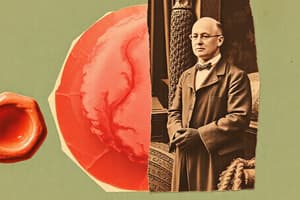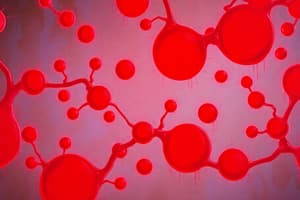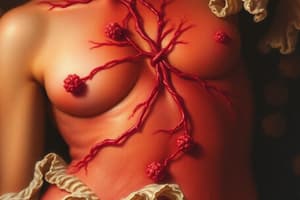Podcast
Questions and Answers
What is the role of von Willebrand factor in hemostasis?
What is the role of von Willebrand factor in hemostasis?
- It inhibits platelet activation.
- It converts fibrinogen to fibrin.
- It stabilizes the platelet plug. (correct)
- It promotes blood vessel dilation.
Which chemical is released by platelets to attract more platelets during plug formation?
Which chemical is released by platelets to attract more platelets during plug formation?
- Thrombin
- Adenosine diphosphate (ADP) (correct)
- Collagen
- Fibrinogen
What is the typical duration for primary hemostasis to occur?
What is the typical duration for primary hemostasis to occur?
- 8-10 minutes
- 3-5 minutes
- 2-7 minutes (correct)
- 1-3 minutes
Which condition is associated with prolonged bleeding time?
Which condition is associated with prolonged bleeding time?
What components make up a clot during secondary hemostasis?
What components make up a clot during secondary hemostasis?
What is the main pathway that activates the coagulation cascade?
What is the main pathway that activates the coagulation cascade?
Fibrin is formed from which precursor during clot formation?
Fibrin is formed from which precursor during clot formation?
How does the fibrin mesh stabilize the platelet plug?
How does the fibrin mesh stabilize the platelet plug?
What process converts plasminogen into plasmin within a clot?
What process converts plasminogen into plasmin within a clot?
What triggers the extrinsic pathway of coagulation?
What triggers the extrinsic pathway of coagulation?
What is a common consequence of increased fibrinolysis in the body?
What is a common consequence of increased fibrinolysis in the body?
Which factor is involved in the conversion of factor VII to its activated form?
Which factor is involved in the conversion of factor VII to its activated form?
What role does thrombin-activated fibrinolysis inhibitor (TAFI) play in clot management?
What role does thrombin-activated fibrinolysis inhibitor (TAFI) play in clot management?
What is the normal range for Prothrombin Time (PT)?
What is the normal range for Prothrombin Time (PT)?
What condition is associated with depressed fibrinolysis?
What condition is associated with depressed fibrinolysis?
Which factor initiates the intrinsic pathway of coagulation?
Which factor initiates the intrinsic pathway of coagulation?
What is a potential outcome of the contraction of approximately 90% of the initial clot volume?
What is a potential outcome of the contraction of approximately 90% of the initial clot volume?
What is the primary difference between the intrinsic and extrinsic pathways?
What is the primary difference between the intrinsic and extrinsic pathways?
At what point do the intrinsic and extrinsic pathways converge?
At what point do the intrinsic and extrinsic pathways converge?
Which factor acts on fibrin strands during the common pathway?
Which factor acts on fibrin strands during the common pathway?
What is the normal range for Activated Partial Thromboplastin Time (aPTT)?
What is the normal range for Activated Partial Thromboplastin Time (aPTT)?
What is the role of factor VIIa in the extrinsic pathway?
What is the role of factor VIIa in the extrinsic pathway?
Damage to which structure primarily triggers the extrinsic pathway?
Damage to which structure primarily triggers the extrinsic pathway?
What is the primary purpose of haemostasis?
What is the primary purpose of haemostasis?
What is a common sign indicating the body's prioritization of blood supply to the brain during severe conditions?
What is a common sign indicating the body's prioritization of blood supply to the brain during severe conditions?
Which physiological response occurs first in primary haemostasis?
Which physiological response occurs first in primary haemostasis?
Which of the following best describes the process that occurs at a cellular level during haemostasis?
Which of the following best describes the process that occurs at a cellular level during haemostasis?
What can be a consequence of losing more than 20% of blood volume?
What can be a consequence of losing more than 20% of blood volume?
In response to injury, what do platelets release to facilitate vasoconstriction?
In response to injury, what do platelets release to facilitate vasoconstriction?
Which of the following symptoms might indicate severe blood loss and the body shutting down?
Which of the following symptoms might indicate severe blood loss and the body shutting down?
Why is maintaining haemostasis particularly important for young children and the elderly?
Why is maintaining haemostasis particularly important for young children and the elderly?
What is the role of platelets in primary haemostasis?
What is the role of platelets in primary haemostasis?
What happens after blood pools into dental sockets post-extraction?
What happens after blood pools into dental sockets post-extraction?
What condition may result from significant blood loss requiring possibly a blood transfusion?
What condition may result from significant blood loss requiring possibly a blood transfusion?
Which of the following describes a minor loss of blood?
Which of the following describes a minor loss of blood?
Which of the following is NOT involved in the vasoconstriction process during primary haemostasis?
Which of the following is NOT involved in the vasoconstriction process during primary haemostasis?
What physiological mechanisms does the body utilize to maintain blood volume and cells?
What physiological mechanisms does the body utilize to maintain blood volume and cells?
What is primarily released by damaged blood vessels to mediate vasoconstriction?
What is primarily released by damaged blood vessels to mediate vasoconstriction?
Which symptom is NOT associated with moderate blood loss?
Which symptom is NOT associated with moderate blood loss?
During the process of coagulation in secondary haemostasis, what is primarily formed?
During the process of coagulation in secondary haemostasis, what is primarily formed?
What role do clotting factors play in haemostasis?
What role do clotting factors play in haemostasis?
A patient presenting with confusion, weakness, and little or no urine output is likely experiencing what?
A patient presenting with confusion, weakness, and little or no urine output is likely experiencing what?
What is primarily affected by rapid blood loss?
What is primarily affected by rapid blood loss?
Flashcards are hidden until you start studying
Study Notes
Haemostasis
- The process that stops bleeding when a blood vessel is damaged.
- Involves three stages:
- Vasoconstriction
- Platelet plug formation
- Coagulation
Primary Haemostasis
- Involves vasoconstriction and platelet plug formation.
- Vasoconstriction:
- Blood vessels constrict, reducing blood flow.
- Mediated by serotonin, thromboxanes, and endothelins.
- Platelet Plug Formation:
- Platelets adhere to damaged blood vessel walls through von Willebrand factor.
- Platelets release ADP, attracting more platelets, forming a plug.
Coagulation (Secondary Haemostasis)
- Complex process, involving a cascade of clotting factors to stabilize the platelet plug with a fibrin mesh.
- Fibrin is formed from soluble fibrinogen.
Clotting Cascade
- A series of reactions involving clotting factors, leading to the formation of fibrin.
- Two main pathways:
- Extrinsic pathway (Tissue factor pathway)
- Intrinsic pathway (Contact pathway)
- Both pathways converge into a common pathway.
Extrinsic Pathway
- Triggered by the release of tissue factor (factor III) from damaged endothelial cells.
- Tissue factor activates factor VII into factor VIIa.
- Factor VIIa activates factor X into factor Xa.
- Measured by Prothrombin Time (PT).
Intrinsic Pathway
- Triggered by blood coming into contact with collagen fibers in the broken blood vessel wall.
- Initiated by factor XII (serine protease), which becomes factor XIIa after exposure to endothelial collagen.
- Ends with the common pathway.
- Measured by Activated Partial Thromboplastin Time (aPTT).
Common Pathway
- Begins at factor X, which is activated into factor Xa.
- Factor Xa converts prothrombin into thrombin.
- Thrombin converts fibrinogen into fibrin.
- Fibrin forms a mesh that stabilizes the platelet plug.
Fibrinolysis
- The breakdown of the clot by plasmin.
- Plasminogen, trapped within the clot, is converted to plasmin by activators released by damaged cells.
- Plasmin breaks down fibrin.
- Abnormal fibrinolysis can lead to bleeding disorders or thrombosis.
Relevance to Dental Hygienists/Therapists
- Understanding haemostasis is essential for managing bleeding after procedures, such as extractions.
- Knowledge of clotting factors and their inhibitors is important for patient care and drug interactions.
- Consideration should be given to patients with haemostatic issues, particularly those with bleeding disorders or on anti-platelet medication.
Studying That Suits You
Use AI to generate personalized quizzes and flashcards to suit your learning preferences.




